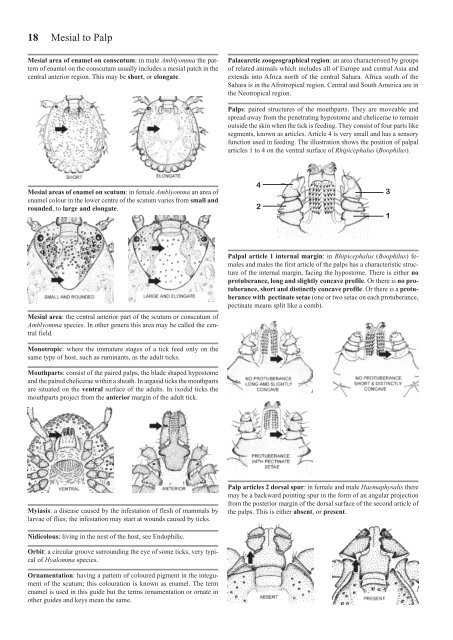Ticks of Domestic Animals in Africa - Alan R Walker - Science Writer
Ticks of Domestic Animals in Africa - Alan R Walker - Science Writer
Ticks of Domestic Animals in Africa - Alan R Walker - Science Writer
You also want an ePaper? Increase the reach of your titles
YUMPU automatically turns print PDFs into web optimized ePapers that Google loves.
18<br />
Mesial to Palp<br />
Mesial area <strong>of</strong> enamel on conscutum: <strong>in</strong> male Amblyomma the pattern<br />
<strong>of</strong> enamel on the conscutum usually <strong>in</strong>cludes a mesial patch <strong>in</strong> the<br />
central anterior region. This may be short, or elongate.<br />
Mesial areas <strong>of</strong> enamel on scutum: <strong>in</strong> female Amblyomma an area <strong>of</strong><br />
enamel colour <strong>in</strong> the lower centre <strong>of</strong> the scutum varies from small and<br />
rounded, to large and elongate.<br />
Mesial area: the central anterior part <strong>of</strong> the scutum or conscutum <strong>of</strong><br />
Amblyomma species. In other genera this area may be called the central<br />
field.<br />
Monotropic: where the immature stages <strong>of</strong> a tick feed only on the<br />
same type <strong>of</strong> host, such as rum<strong>in</strong>ants, as the adult ticks.<br />
Mouthparts: consist <strong>of</strong> the paired palps, the blade shaped hypostome<br />
and the paired chelicerae with<strong>in</strong> a sheath. In argasid ticks the mouthparts<br />
are situated on the ventral surface <strong>of</strong> the adults. In ixodid ticks the<br />
mouthparts project from the anterior marg<strong>in</strong> <strong>of</strong> the adult tick.<br />
Myiasis: a disease caused by the <strong>in</strong>festation <strong>of</strong> flesh <strong>of</strong> mammals by<br />
larvae <strong>of</strong> flies; the <strong>in</strong>festation may start at wounds caused by ticks.<br />
Nidicolous: liv<strong>in</strong>g <strong>in</strong> the nest <strong>of</strong> the host, see Endophilic.<br />
Orbit: a circular groove surround<strong>in</strong>g the eye <strong>of</strong> some ticks, very typical<br />
<strong>of</strong> Hyalomma species.<br />
Ornamentation: hav<strong>in</strong>g a pattern <strong>of</strong> coloured pigment <strong>in</strong> the <strong>in</strong>tegument<br />
<strong>of</strong> the scutum; this colouration is known as enamel. The term<br />
enamel is used <strong>in</strong> this guide but the terms ornamentation or ornate <strong>in</strong><br />
other guides and keys mean the same.<br />
Palaearctic zoogeographical region: an area characterised by groups<br />
<strong>of</strong> related animals which <strong>in</strong>cludes all <strong>of</strong> Europe and central Asia and<br />
extends <strong>in</strong>to <strong>Africa</strong> north <strong>of</strong> the central Sahara. <strong>Africa</strong> south <strong>of</strong> the<br />
Sahara is <strong>in</strong> the Afrotropical region. Central and South America are <strong>in</strong><br />
the Neotropical region.<br />
Palps: paired structures <strong>of</strong> the mouthparts. They are moveable and<br />
spread away from the penetrat<strong>in</strong>g hypostome and chelicerae to rema<strong>in</strong><br />
outside the sk<strong>in</strong> when the tick is feed<strong>in</strong>g. They consist <strong>of</strong> four parts like<br />
segments, known as articles. Article 4 is very small and has a sensory<br />
function used <strong>in</strong> feed<strong>in</strong>g. The illustration shows the position <strong>of</strong> palpal<br />
articles 1 to 4 on the ventral surface <strong>of</strong> Rhipicephalus (Boophilus).<br />
4<br />
2<br />
Palpal article 1 <strong>in</strong>ternal marg<strong>in</strong>: <strong>in</strong> Rhipicephalus (Boophilus) females<br />
and males the first article <strong>of</strong> the palps has a characteristic structure<br />
<strong>of</strong> the <strong>in</strong>ternal marg<strong>in</strong>, fac<strong>in</strong>g the hypostome. There is either no<br />
protuberance, long and slightly concave pr<strong>of</strong>ile. Or there is no protuberance,<br />
short and dist<strong>in</strong>ctly concave pr<strong>of</strong>ile. Or there is a protuberance<br />
with pect<strong>in</strong>ate setae (one or two setae on each protuberance,<br />
pect<strong>in</strong>ate means split like a comb).<br />
Palp articles 2 dorsal spur: <strong>in</strong> female and male Haemaphysalis there<br />
may be a backward po<strong>in</strong>t<strong>in</strong>g spur <strong>in</strong> the form <strong>of</strong> an angular projection<br />
from the posterior marg<strong>in</strong> <strong>of</strong> the dorsal surface <strong>of</strong> the second article <strong>of</strong><br />
the palps. This is either absent, or present.<br />
3<br />
1


